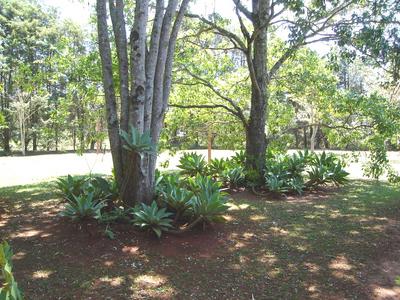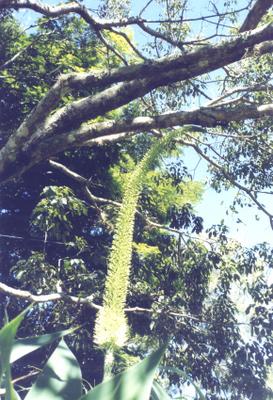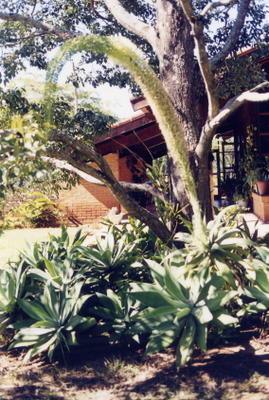 Click on photos to enlarge
Click on photos to enlarge 



My garden is not much tidy and I struggle a lot against a legion of hungry ants. Many times these numerous insects invade my garden, with their jaws open and shut like a pair of scissors, cutting down my flowers and plants. Ants occur worldwide but are especially common in hot climates, like my region. (It’s amazing, 22,000 ant species are expected to live on planet Earth!). But there is a great winner and survival on my garden: the beautiful and imposing Agave attenuata. Agave attenuata is a species of agave (succulent plants) sometimes known as the “elephant’s trunk”, "lion's tail", "swan's neck", or "foxtail" for its development of a curved stem, unusual among agaves. Native to the plateau of central Mexico, it is popular as an ornamental plant in gardens. Chiefly Mexican, they occur also in the southern and western United States and in central and tropical South America.
The stems typically range from 50-150 cm in length, and eventually old leaves fall off, leaving them naked and visible. The plants have a large rosette of thick fleshy leaves generally ending in a sharp point. It may take up to 10 years to bloom. My Agave attenuata take up 20 years to blooming! Attenuata’s flower spike is a thing of wonder, and will either produce greenish-yellow flowers or thousands of small plantlets, on its' entire length. Each plant stalk blooms only once. Unlike other members of it's family this plant doesn't die after flowering.
Agave attenuata are best propagated by digging pups produced at the base of older plants and seeds germinate readily when they are fresh. These plants needs full sun to partial shade, with a well-drained soil mix. I like to make gifts to my friends with an Agave’s pups.


How interesting, Sonia! I have nothing in my Indiana garden in that looks like that!
ReplyDeleteYour friends must feel very fortunate to receive a gift from your garden.
This makes my little Illinois perennial garden look pretty pitiful! (Although I will have to take some pictures of the asters that are now in full bloom... lovely!). Thanks for such an interesting post and beautiful pictures!
ReplyDeleteThis comment has been removed by a blog administrator.
ReplyDeleteBeautiful!
ReplyDeleteThat flower spike is amazing! Is this the same agave plant I saw in central Mexico that they make tequila from? Maybe from the same family of plants. Anyway, very interesting to learn about your garden.
ReplyDeleteVery interesting !!
ReplyDeleteAs "jan " ,I think your friends must be enjoy in your house !!!
Hello Sonia--
ReplyDeleteWonderful information about the Agave attenuata. I think there may be varations of that in southern California, I seem to remember seeing something like it there. Also interesting about the voracious ants you have there.
You commented on our blog this morning, and it was lovely to read you here.
Hello, Sonia,
ReplyDeleteHow wonderful you found me and now I am finding your gardens--beautiful. I feel as if I am travelling to a wonderful place. I will keep returning...I also battle ants, but coming from New England, mine must be smaller than yours??? Ants are such a problem, aren't they? I look forward to reading about your plants & insects, etc. Good luck with your blog!
This comment has been removed by a blog administrator.
ReplyDeleteLeslee, it’s another species of Agave: from Wikipedia I quote this: "The tequila agave Agave tequilana Weber, often called blue agave or agave azul, is an agave, a principal economic product of Jalisco state in Mexico due to its role as the base ingredient of tequila, a popular alcoholic drink. Tequila is produced by removing the heart of the plant in its twelfth year, normally weighing between 35-90 kg. This heart is stripped of leaves and heated to remove the sap, which is fermented and distilled. Other beverages like Mezcal and Pulque are also produced from Blue and other agaves by different methods (though still using the sap) and are regarded as more traditional".
ReplyDeleteThey are beautiful, Sonia. I am impressed with your links! Wish I could do some too.
ReplyDeleteyour home is beautiful...and so is your english. :D
ReplyDeleter.
That is incredibly beautiful, Sonia. It must make you feel so good to have something finally bloom after 20 years!
ReplyDeletesonia... wow... waiting for something to bloom for 20 years... it's like tending a child:) your garden is so beautiful... makes me even more anxious to have a place where i can garden. i've been catering to bonsai trees and potted palm plants at the moment, but i can't wait to get outside and plant and watch things grow...
ReplyDeleteI too love agave plants but they don't grow here at this freezing altitude of almost 7,000 feet.
ReplyDeleteA beautiful speciman you have there!
Wow, your agave are amazing. I have one agave in a pot in my garden, but it has never flowered, nor has it had pups!!!
ReplyDeleteHey. Wonderful plants aren`t they. My grandma has them, lots as well. But I don`t think she has as much as you. I live in Australia and I was thinking of selling some. How much are they worth? If you know please contact me. My email adress is Phoolish_Heart@hotmail.com
ReplyDeleteBye!
Hello -
ReplyDeleteI have fallen for the agave attenuata myself! I have always been intrigued by a certain garden I once passed while jogging one morning. Since then, I tried looking for the plant in my local nursery here in California but was not lucky enough to find one. Until finally, I summoned enough courage to drive to that certain garden where I saw the agave plants, knocked on the door, and asked if I could have a pup. Not only did I get a pup, I got at least 5 ones! Suffice it to say, I'm very happy.
I do however need to know more about these plants and how I can be successful growing them. I would hate to go back and ask for more pups should the ones the nice lady gave me die.
One or two of the suckers she gave me has roots in them, others don't but just the base, and 1 has healthy root but there is a crack between the base and the roots. Which one has likelihood of success? Will the ones without roots grow, too?
I would appreciate any tips on growing them. Also, where do I find the seeds? I can see the suckers (pups) but I have no clue where the seeds are.
Thank you very much. I will look forward to any tip.
Agave-Attenuata-in-Berkeley, CA
Sonia, I live in San Diego California, USA near the coasal zone. I have lived here 41 years and the agave that was here when I moved in just bloomed for the first time 2 years ago. It was Christmas here and I wrapped the huge bloom stalk with decorative tinsel. I still wonder when the other 7 adults will bloom. Greg
ReplyDeleteVery lovely Sonia--and I love your new blog header too!!
ReplyDeleteHi Sonia you might be able to help me? My Agave Attenuata has just finished flowering what do i do with the flower stalk do i leave it or cut i down? I really do not want to hurt my lovely Agave. Heather from Ozzie.
ReplyDeleteHi Heather,
ReplyDeleteI am not an expert, but I think you don't need to cut it down. I did not cut the flower you see on photos. But for more information, click HERE.
Thanks for your visiting and comment.
Do you have a blog?